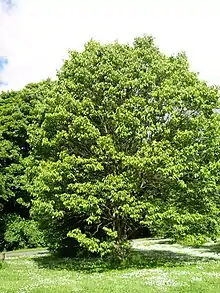| Hovenia | |
|---|---|
 | |
| Japanese raisin tree, Hovenia dulcis | |
| Scientific classification | |
| Kingdom: | Plantae |
| Clade: | Tracheophytes |
| Clade: | Angiosperms |
| Clade: | Eudicots |
| Clade: | Rosids |
| Order: | Rosales |
| Family: | Rhamnaceae |
| Tribe: | Paliureae |
| Genus: | Hovenia Thunb. |
| Species | |
|
See text | |
Hovenia is a small genus of deciduous trees or shrubs in the family Rhamnaceae. They occur naturally from India to Japan. The Japanese, or Oriental raisin tree, Hovenia dulcis, is the best known species, as it is often planted in gardens outside Asia.
Fossil record
A fossil wood with features similar to those of the Oligocene Hovenia palaeodulcis from Japan is described from the late Eocene Florissant Fossil Beds National Monument, Colorado, United States. This is the first report of fossil wood of this Asian genus in North America.[1]
Selected species

Hovenia dulcis, fruit
- syn Hovenia kiukiangensis
- Hovenia dulcis Thunb.
- syn Hovenia inaequalis DC.
- Hovenia parviflora
- Hovenia pubescens
- Hovenia robusta
- Hovenia tomentella
- Hovenia trichocarpa
References
- ↑ A New (Hovenia) and an old (Chadronoxylon) Fossil Wood from the Late Eocene Florissant Formation, Colorado, U.S.A. by Elisabeth Wheeler and Herbert W. Meyer, IAWA journal / International Association of Wood Anatomists (Impact Factor: 1.07). 01/2012; 33(3). DOI: 10.1163/22941932-90000096
This article is issued from Wikipedia. The text is licensed under Creative Commons - Attribution - Sharealike. Additional terms may apply for the media files.